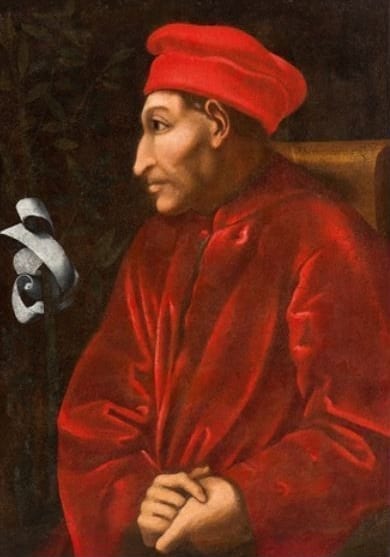Florence in the fifteenth century was one of the most important cities in Western Europe. Rich and resplendent, first in banking and in the wool trade, it even issued its own currency, the golden florin, widely used throughout Europe. For some three hundred years the city was ruled almost continuously by the Medici, at one time the richest family in Europe. Their coat of arms with its red balls (or balle) on a golden field has been variously interpreted as representing victory, or coins, or perhaps that the Medici—as their name implied—had once been apothecaries or physicians and that the red balls signified pills or cupping glasses.1
The first notable member of the family was Giovanni di Bicci (1360–1429). He expanded the Medici fortune and stayed clear of politics, confining himself to banking and commerce. His son Cosimo the Elder (il Vecchio, 1389–1464) would have also preferred to remain so, but was forced into political action when unjustly exiled by a conspiracy of the dominant Albizzi family.1 Once able to return, he expelled his enemies and assumed power in 1433. He greatly improved the status of Florence, for which he was remembered and revered as Pater Patriae. He was followed by Piero the Gouty, the famous Lorenzo the Magnificent (1449–1492), and then two further generations of descendants. Eventually power passed to a collateral branch of the family, the Grand Dukes of Tuscany, Cosimo I (1519–1574), Ferdinand (1549–1609), and several others, until the family died out in 1737.1
Most of the Medici had some form of joint disease. Contemporaries called it gout, and it probably was so, although at that time gout was not well distinguished from other forms of rheumatism. But much light has been thrown on this subject beginning in 1945, when four generations of the Medici were exhumed from their family chapel in the Church of San Lorenzo, making it possible to study at least fifteen skeletons.2
Gout, of course, was the first disease that was looked for, seeing that it affected so many members of the family. Interestingly, urate deposits were found only in the skeleton of Ferdinand I, but this by no means excludes clinical gout in the others. It is worth noting in this context that many wealthy Englishmen formerly suffered from gout from drinking port wine shipped from Portugal in lead caskets. In their splendid palaces the Medici undoubtedly enjoyed a rich fare, and may well have been exposed to some wine or food or even contaminated water (such as from lead pipes) causing their painful gout.
But the Medici also suffered from other bone and joint diseases. Piero the Gouty (1416–1469) may have also had rheumatoid or psoriatic arthritis, as he was so incapacitated that during the five years of his reign he often had to be carried about in a litter.1 There was also evidence suggestive of rheumatoid arthritis in several other skeletons, notably in that of Cardinal Carlo (1596–1666), who in addition to other skeletal abnormalities (some congenital, as well as tuberculosis) was found to have the HLA–DR4 antigen highly associated with rheumatoid arthritis.3
It is also necessary to account for involvement of the spinal column, best seen in the famous portrait of Cosimo the Elder by Jacopo Pontormo. Although it was painted some fifty years after Cosimo’s death, it clearly showed a curvature of the spine and swelling of the joints of the wrist suggestive of ankylosing spondylitis.4 More recently, however, investigators have found (in the skeletons of Cosimo the Elder, Cosimo I, and Ferdinand I) evidence of another disease, Forestier’s disease or diffuse idiopathic skeletal hyperostosis (abbreviated as DISH).5-7
Described in 1950, DISH is characterized by calcification or ossification of the ligaments attached to the spine. Protruding bone spurs are formed, and there is generalized bone hardening and overgrowth. The disease may also affect the neck and lower back, and sometimes the shoulders, elbows, knees, and heels, and there may also be radiographic evidence of thickening of the skull. Symptoms are often mild but occasionally severe, resembling ankylosing spondylitis, with curvature and rigidity of the spinal column, such as described in Cosimo the Elder.4 More needs to be learned about this disease, which investigators have variously claimed or denied8 to be associated with an elite status, an affluent lifestyle, and a high caloric diet with excessive intake of meat and wine.
We are thus left to conclude, putting together the clinical stories and the recent evidence from what has been called paleopathology,1,9 that the Medici suffered from at least three different joint diseases, some possibly related, some perhaps merely coexisting in the same person.9 And quite likely the last word on this interesting subject has not yet been written.




References
- Christopher Hibbert. The rise and fall of the house of Medici, Penguin Books, 1974.
- Fornaciari G, Giuffra V, Giussiani S, et al. The “gout” of the Medici, Grand Dukes of Florence: a paleopathological study. Rheumatology 2009, 48:375.
- Giuffra V, Vitiello, Giussiani S, et al. Rheumatoid arthritis, Klippel-Feil syndrome and Pott’s disease in Cardinal Carlo de’Medici (1595-1666). Clinical and Experimental Rheumatology 2009; 27: 594-602.
- Strauss RM, Marzo- Ortega. Cosimo di Medici’s arthritis. JR Coll Physicians Edinb. 2002, 32:212.
- Forestier J, Rotes Querol J . Senile ankylosing hyperostosis of the spine. Ann Rheum Dis. 1950,9:321.
- Giuffra V, Giusiani S,Fornaciari A. Diffuse idiopathic skeletal hyperostosis in the Medici, Grand Dukes of Florence (XVI century). European Spine Journal 2010,19: Supplement 2, pp 103–107.
- Tonelli F. Was it true gout? New interpretations of the skeletal disease(s) of the Medici family. Clin Cases Miner Bone Metab 2012,8(20;52).
- George M Weisz. Comment on: The “gout” of the Medici, Grand dukes Of Florence: a paleopathological study. Rheumatol. 2009,48:1015.
- Giuffra V,Minozzi S, Vitiello A, Fornaciari A. On the history of gout: paleopathological evidence from the Medici family of Florence. Clin Exp Rheumatol 2017,35:321
